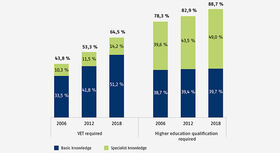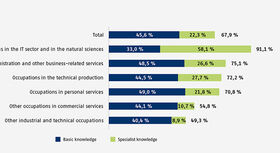Foreign language requirements in the world of work
Results of the 2006, 2012 and 2018 BIBB/BAuA Employment Surveys
Anja Hall
Knowledge of foreign languages is becoming increasingly important in working life in light of economic globalisation and international interconnectedness. This article uses the 2006, 2012 and 2018 BIBB/BAuA Employment Surveys to show the importance attached to knowledge of foreign languages in today’s world of work, to highlight how these requirements have developed over time, and to identify the occupations in which such knowledge plays a particularly major role.
Foreign languages as a core competence
Competence in foreign languages is increasingly growing in significance in light of the ongoing globalisation of the economy and of labour markets. Knowledge of foreign languages has now become one of the core competencies sought by companies (cf. SCHÖPPER-GRABE 2009). Results from company surveys conducted in Germany demonstrate that firms have a high need for foreign languages and that this requirement is also differentiated depending on their respective business relationships, size, sector and region (cf. RÖMER et al 2004; ROSS/KERNT/SKIBA 1996; SCHÖPPER-GRABE 2009). Foreign languages have meanwhile become an integral part of everyday working life in many jobs. They are, for example, used to communicate with partners or customers from abroad, to read and write texts and to understand specialist terms in English. In earlier times, good knowledge of foreign languages was primarily a requirement for management staff, scientists and staff working in foreign departments. Nowadays, however, it is becoming increasingly rare to find any areas in which foreign languages are not needed (cf. SCHÖPPER-GRABE 2009). English is the foreign language most commonly used in the world of work. The need for foreign languages and the level at which they are required are ultimately determined by socio-demographic, company and occupational characteristics (cf. HALL 2008).
BIBB/BAuA Employment Survey (ETB)
The BIBB/BAuA Employment Survey is conducted by the Federal Institute for Vocational Education and Training (BIBB) in conjunction with the Federal Institute for Occupational Safety and Health (BAuA) every six years. The most recent study was carried out at the turn of 2017/2018 (ETB 2018). The basic population comprises gainfully employed persons aged 15 years and above (not including trainees) who are in regular paid employment for at least ten hours per week (“core employed persons”). Each survey collects data relating to around 20,000 core employed persons via computer-assisted telephone interviews (CATI). The data acquired is representative of this group. Data is adapted to the structures of the statistical population via weighting in accordance with central characteristics on the basis of the microcensus.
For further information, please visit: www.bibb.de/arbeit-im-wandel.
Foreign language requirements in the world of work
The analyses are based on the 2018 BIBB/BAuA Employment Survey and they showed that around 68 percent of the employed persons in Germany needs knowledge of foreign languages. Basic knowledge is required in 45.6 percent of cases, whereas specialist knowledge is necessary for 22.4 percent. The proportion of employed persons using foreign languages in their work activity rises in line with the level of qualification requirement, especially in terms of specialist knowledge (cf. also www.demowanda.de and Fig. 1). The representative BIBB/BAuA Employment Surveys (ETB, cf. information box) are also used for the following analyses.
Operationalisations in the ETB
Knowledge of foreign languages – ETB 2006 and 2012: “In your task as a <…>, do you require basic or specialist knowledge of languages other than German?” ETB 2018: “In your task as a <…>, do you require basic or specialist knowledge of languages other than English and German?”
Requirements level – “What sort of training is usually required to carry out your task as a <…> ? Completion of vocational education and training, a degree from a university of applied sciences or a university, an advanced training qualification, e.g. master craftsman or technician, or no training qualification?”
Occupation exercised – occupations were pooled into five occupational sectors on the basis of the 2010 Classification of Occupations (KldB 2010) to form vocationally homogeneous main occupational groups (cf. MATTHES/MEINEKEN/NEUHAUSER 2015). For the purpose of the present article, the large sector of manufacturing occupations were differentiated into “occupations in the technical production” and “other industrial and technical occupations”.
Foreign language requirements increasing over time

Foreign language competencies are also developing more and more into a core competence for those who have completed vocational education and training. A particularly large increase over time is noted in relation to tasks which usually require a vocational qualification (medium requirements level) (cf. Fig. 1). 33.5 percent of the employed persons required basic foreign language knowledge in 2006. By 2018, the figure had already risen to 51.2 percent (2012: 41.8%). With regard to specialist knowledge, proportions at the medium requirements level went up from 10.3 percent in 2006 to 14.2 percent in 2018 (2012: 11.5%). The proportion of employed persons at this level for whom foreign languages do not play a role in their activity declined from 56.2 percent in 2006 to 34.6 percent in 2018.
Whereas specialist knowledge is demanded in a majority of the tasks usually requiring a university degree, most people performing a task at the medium requirements level only need basic knowledge of foreign languages (cf. Fig. 1). In 2018, almost one in two (49%) respondents carrying out a task at an academic qualifications level required foreign languages in their work. The corresponding figure for 2006 was 39.6 percent. For highly skilled tasks it is only the level of specialist knowledge that has become more important over time.
Foreign language requirements vary with the current occupation

A differentiated consideration according to occupational sector (cf. Fig. 2) shows that service occupations in the IT sector and in the natural sciences are the areas in which knowledge of foreign languages is most frequently required (91.1 percent). This knowledge is also more likely (58.1% of cases) to be needed at a specialist level than in other occupations. Occupations in business administration and other business-related services (75.1%), occupations in the technical production (72.2%) and occupations in personal services (70.8%) all occupy a mid-table position in this regard. No significant difference in respect of extent or level exists in these instances. Foreign languages are less likely to be needed for the exercising of other industrial and technical occupations (49.3%) and of other occupations in commercial services (54.8%). In these particular occupational sectors, any knowledge needed is mostly confined to a basic level.
In relation to the 37 main occupational groups of the 2010 Classification of Occupations (KldB 2010) the primary groups in which specialist knowledge in foreign languages is required more frequently than average are occupations in computer science and other ICT occupations (67.5%), occupations in technical research and development, construction, and production planning and scheduling (39.6%) and occupations in procurement and sales and commercial occupations (38.4%).
By contrast, specialist knowledge of foreign languages is of little importance in occupations in interior construction and in cleaning services. The occupations in which basic knowledge in foreign languages is required more frequently than average are occupations in safety and health protection, security and surveillance (69.6%), occupations in tourism, hotels and restaurants (53.7%) and sales occupations in the retail trade and medical and healthcare occupations (58.2% in each case).
Since 2006 foreign language requirements have increased, especially for other industrial-technical occupations at the level of basic knowledge (cf. the interactive graphic included as an electronic supplement to the present article, see below).
Literature
Hall, A.: Fremdsprachen im Beruf - Wer benötigt Fremdsprachenkenntnisse und auf welchem Niveau? In: Tritscher-Archan, S. (Ed.): Fremdsprachen für die Wirtschaft. Analysen, Zahlen, Fakten. IBW-Forschungsbericht 142. Wien 2008, pp. 217-233
Matthes, B.; Meineken, H.; Neuhauser, P.: Berufssektoren und Berufssegmente auf Grundlage der KldB 2010. Methodenbericht der Statistik der BA. Nürnberg 2015
Römer, C. u.a.: Bilateraler Fremdsprachenbedarf in Deutschland und Frankreich – Eine Bestandsaufnahme in Großunternehmen. Abschlussbericht. Köln 2004
Ross, E.; Kern, F.; Skiba, R.: Facharbeiter und Fremdsprachen: Fremdsprachenbedarf und Fremdsprachennutzung in technischen Arbeitsfeldern. Eine qualitative Untersuchung. Bielefeld 1996
Schöpper-Grabe, S.: Betrieblicher Fremdsprachenbedarf im deutschsprachigen Raum. In: Truchot, C. (Ed.): Sprachwahl in Europäischen Unternehmen (Sociolinguistica Bd. 23). Berlin 2009, pp. 150-162
Further materials supplementing the data presented in this article
- Table by main occupational groups 2018 available at www.bwp-zeitschrift.de/en/bwp.php/en/bwp/grafik/467
- Interactive graphic on foreign language requirements by occupation exercised over the course of time available at www.bwp-zeitschrift.de/en/bwp.php/en/bwp/grafik/470
More infographics on the basis of the ETB relating to core competencies in the world of work such as IT competencies or methodological competencies may also be consulted on the Internet portal of the demowanda “Demographic Change in the World of Work” Initiative at www.demowanda.de.
DR. ANJA HALL
Academic researcher at BIBB
Translation from the German original (published in BWP 1/2021): Martin Kelsey, GlobalSprachTeam, Berlin